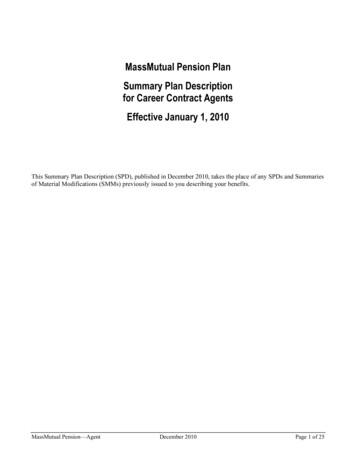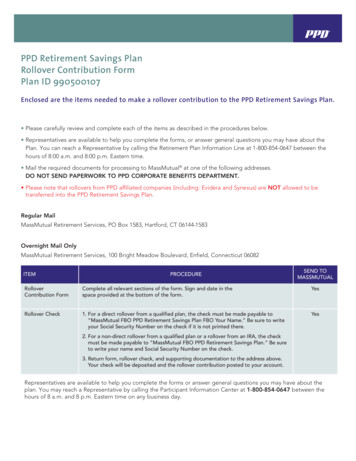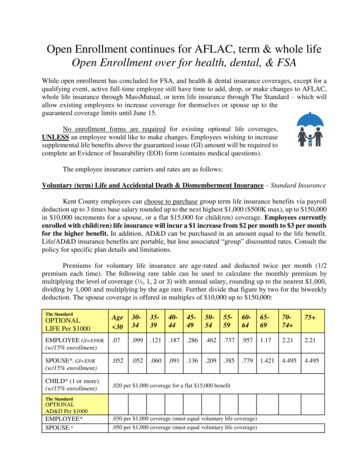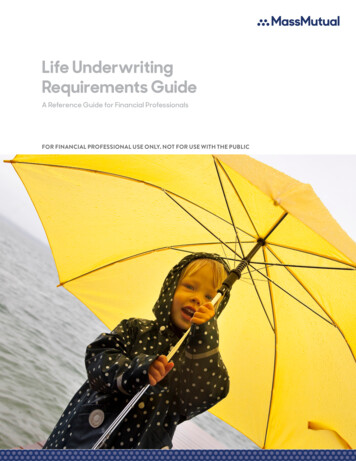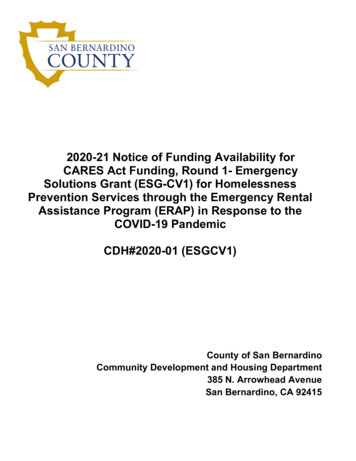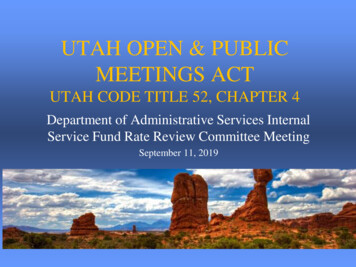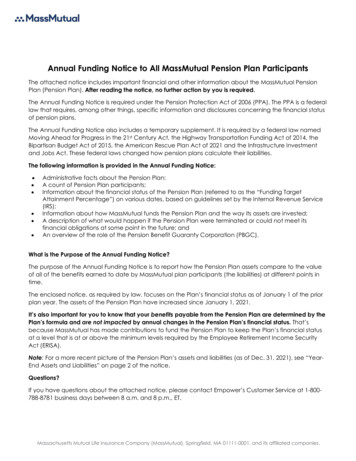
Transcription
Annual Funding Notice to All MassMutual Pension Plan ParticipantsThe attached notice includes important financial and other information about the MassMutual PensionPlan (Pension Plan). After reading the notice, no further action by you is required.The Annual Funding Notice is required under the Pension Protection Act of 2006 (PPA). The PPA is a federallaw that requires, among other things, specific information and disclosures concerning the financial statusof pension plans.The Annual Funding Notice also includes a temporary supplement. It is required by a federal law namedMoving Ahead for Progress in the 21st Century Act, the Highway Transportation Funding Act of 2014, theBipartisan Budget Act of 2015, the American Rescue Plan Act of 2021 and the Infrastructure Investmentand Jobs Act. These federal laws changed how pension plans calculate their liabilities.The following information is provided in the Annual Funding Notice: Administrative facts about the Pension Plan;A count of Pension Plan participants;Information about the financial status of the Pension Plan (referred to as the “Funding TargetAttainment Percentage”) on various dates, based on guidelines set by the Internal Revenue Service(IRS);Information about how MassMutual funds the Pension Plan and the way its assets are invested;A description of what would happen if the Pension Plan were terminated or could not meet itsfinancial obligations at some point in the future; andAn overview of the role of the Pension Benefit Guaranty Corporation (PBGC).What is the Purpose of the Annual Funding Notice?The purpose of the Annual Funding Notice is to report how the Pension Plan assets compare to the valueof all of the benefits earned to date by MassMutual plan participants (the liabilities) at different points intime.The enclosed notice, as required by law, focuses on the Plan’s financial status as of January 1 of the priorplan year. The assets of the Pension Plan have increased since January 1, 2021.It’s also important for you to know that your benefits payable from the Pension Plan are determined by thePlan’s formula and are not impacted by annual changes in the Pension Plan’s financial status. That’sbecause MassMutual has made contributions to fund the Pension Plan to keep the Plan’s financial statusat a level that is at or above the minimum levels required by the Employee Retirement Income SecurityAct (ERISA).Note: For a more recent picture of the Pension Plan’s assets and liabilities (as of Dec. 31, 2021), see “YearEnd Assets and Liabilities” on page 2 of the notice.Questions?If you have questions about the attached notice, please contact Empower’s Customer Service at 1-800788-8781 business days between 8 a.m. and 8 p.m., ET.Massachusetts Mutual Life Insurance Company (MassMutual), Springfield, MA 01111‐0001, and its affiliated companies.
Supplement to Annual Funding Notice ofMassMutual Pension Plan (Plan) forPlan Year Beginning January 1, 2021 and Ending December 31, 2021 (Plan Year)This is a temporary supplement to your annual funding notice which is required by the Moving Ahead forProgress in the 21st Century Act, the Highway and Transportation Funding Act of 2014, the BipartisanBudget Act of 2015, the American Rescue Plan Act of 2021, and the Infrastructure Investment and JobsAct. These federal laws changed how pension plans calculate their liabilities. The purpose of thissupplement is to show you the effect of these changes. Prior to 2012, pension plans determined theirliabilities using a two-year average of interest rates. Now pension plans also must take into account a 25year average of interest rates. This means that interest rates likely will be higher and plan liabilities lowerthan they were under prior law. As a result, your employer may contribute less money to the plan at atime when market interest rates are at or near historical lows.The “Information Table” compares the impact of using interest rates based on the 25-year average (the“adjusted interest rates”) and interest rates based on a two-year average on the Plan’s: (1) FundingTarget Attainment Percentage, (2) Funding Shortfall, and (3) Minimum Required Contribution. Thefunding target attainment percentage is a measure of how well the plan is funded on a particular date.The funding shortfall is the amount by which liabilities exceed net plan assets. The minimum requiredcontribution is the amount of money an employer is required by law to contribute to a plan in a given year.The following table shows this information determined with and without the adjusted interest rates. Theinformation is provided for the Plan Year and for each of the two preceding plan years, if applicable.Information Table2021WithAdjustedInterest RatesFunding TargetAttainment Percentage2020WithoutAdjustedInterest RatesWithAdjustedInterest Rates2019WithoutAdjustedInterest RatesWithAdjustedInterest RatesWithoutAdjustedInterest g Shortfall 0 254,329,053 0 273,059,806 0 255,305,872Minimum RequiredContribution 0 71,832,910 128,962 81,712,661 0 78,755,653(Temporary Supplement)
ANNUAL FUNDING NOTICE FORMASSMUTUAL PENSION PLANIntroductionThis notice includes important information about the funding status of your pension plan (the “Plan”). Italso includes general information about the benefit payments guaranteed by the Pension BenefitGuaranty Corporation (“PBGC”), a federal insurance agency. All traditional pension plans (called “definedbenefit pension plans”) must provide this notice every year regardless of their funding status. This noticedoes not mean that the Plan is terminating. It is provided for informational purposes and you are notrequired to respond in any way. This notice is required by federal law. This notice is for the plan yearbeginning January 1, 2021 and ending December 31, 2021 (“Plan Year”). The figures containedthroughout this notice reflect the pension relief provisions of the American Rescue Plan Act of 2021(ARPA). The Plan Sponsor elected to apply provisions under Sections 9705 and 9706 of ARPA for theJanuary 1, 2021 Plan Year.How Well Funded Is Your PlanThe law requires the administrator of the Plan to tell you how well the Plan is funded, using a measurecalled the “funding target attainment percentage.” The Plan divides its Net Plan Assets by Plan Liabilitiesto get this percentage. In general, the higher the percentage, the better funded the plan. The Plan’sFunding Target Attainment Percentage for the Plan Year and each of the two preceding plan years isshown in the chart below. The chart also shows you how the percentage was calculated.Funding Target Attainment Percentage202120202019January 1, 2021January 1, 2020January 1, 2019 2,696,982,688 2,631,399,294 2,528,554,592b. Funding StandardCarryover Balance 201,617,715 175,993,117 147,274,575c. 316,227,457 276,036,537 230,992,918 2,179,137,516 2,179,369,640 2,150,287,099 2,004,668,960 2,111,917,973 2,017,670,325108.70%103.19%106.57%1. Valuation Date2. Plan Assetsa. Total Plan AssetsPrefunding Balanced. Net Plan Assets(a) - (b) - (c) (d)3. Plan Liabilities4. Funding TargetAttainment Percentage(2d)/(3)Plan Assets and Credit BalancesThe chart above shows certain "credit balances" called the Funding Standard Carryover Balance (line 2b)and Prefunding Balance (line 2c). A plan might have a credit balance, for example, if in a prior year anemployer contributed money to the plan above the minimum level required by law. Generally, anemployer may credit the excess money toward the minimum level of contributions required by law that itmust make in future years. Plans must subtract these credit balances from Total Plan Assets (line 2a) tocalculate their Funding Target Attainment Percentage (line 4).Plan LiabilitiesPlan Liabilities in line 3 of the chart above is an estimate of the amount of assets the Plan needs on theValuation Date to pay for promised benefits under the Plan.(Page 1 of 4)
Year-End Assets and LiabilitiesThe asset values in the chart above are measured as of the first day of the Plan Year and are ‘actuarialvalues.’ Because market values can fluctuate daily based on factors in the marketplace, such as changesin the stock market, pension law allows plans to use actuarial values that are designed to smooth outthose fluctuations for funding purposes. The asset values below are market values and are measured asof the last day of the Plan Year. Market values tend to show a clearer picture of a plan’s funded status ata given point in time. As of December 31, 2021, the fair market value of the Plan’s assets was 3,088,380,899. On this same date, the Plan’s liabilities, determined using market rates, were 2,601,105,872.Participant InformationThe total number of participants and beneficiaries covered by the Plan on the Valuation Date was 25,758.Of this number, 14,577 were active participants, 4,530 were retired and receiving benefits, and 6,651were retired or separated from service and have a right to future benefits.Funding & Investment PoliciesEvery pension plan must have a procedure for establishing a funding policy to carry out plan objectives. Afunding policy relates to how much money is needed to pay promised benefits. The funding policy of thePlan is that contributions consist solely of amounts funded by the Company. It is the policy of theCompany to annually fund at least an amount which satisfies the minimum funding requirement of theEmployee Retirement Income Security Act and the Internal Revenue Code.Once money is contributed to the Plan, the money is invested by plan officials called fiduciaries whomake specific investments in accordance with the Plan’s investment policy. Generally speaking, aninvestment policy is a written statement that provides the fiduciaries who are responsible for planinvestments with guidelines or general instructions concerning investment management decisions. Theprimary investment objective of the Plan is to construct and manage a portfolio of assets that is adequateto support the liability associated with the Plan’s defined benefit obligation. This liability has a long-termduration and its characteristics are determined primarily by the Plan’s benefit formula, inflation, participantdemographics, and actuarial assumptions and factors.Under the investment policy, the Plan’s assets were allocated among the following categories ofinvestments, as of the end of the Plan Year. These allocations are percentages of total assets:Asset AllocationsPercentage Cash (interest bearing and non-interest bearing) U.S. Government securities Corporate debt instruments (other than employer securities) 0.00%12.90% Preferred0.00% All other21.37%Corporate stocks (other than employer securities): Preferred0.00% Common31.03% Partnership/joint venture interests Real estate (other than employer real property)4.34% Loans (other than to participants)0.00% Participant loans0.00% Value of interest in common/collective trusts4.73% Value of interest in pooled separate accounts0.00% Value of interest in master trust investment accounts0.00% Value of interest in 103-12 investment entities0.00%(Page 2 of 4)11.74%
Value of interest in registered investment companies (e.g., mutual funds)0.00% Value of funds held in insurance co. general account (unallocated contracts)6.35% Employer-related investments: Employer Securities0.00% Employer real property0.00% Buildings and other property used in plan operation0.00% Other7.54%For information about the plan's investment in any of the following types of investments as described in thechart above - common/collective trusts, pooled separate accounts, master trust investment accounts, or103-12 investment entities contact Empower Retirement’s Participant Information Center toll-free at 800788-8781 business days between 8 a.m. and 8 p.m. ETRight to Request a Copy of the Annual ReportPension plans must file annual reports with the US Department of Labor. The report is called the “Form5500.” These reports contain financial and other information about the Plan. You may obtain an electroniccopy of your Plan’s annual report by going to www.efast.dol.gov and using the search tool. Annual reportsalso are available from the US Department of Labor, Employee Benefits Security Administration’s PublicDisclosure Room at 200 Constitution Avenue, NW, Room N-1515, Washington, DC 20210, or by calling202-693-8673. Or you may obtain a copy of the Plan’s annual report by making a written request to theplan administrator. Annual reports do not contain personal information, such as the amount of youraccrued benefits. You may contact your plan administrator if you want information about your accruedbenefits. Your plan administrator is identified below under “Where to Get More Information.”Summary of Rules Governing Termination of Single-Employer PlansIf a plan terminates, there are specific termination rules that must be followed under federal law. Asummary of these rules follows.There are two ways an employer can terminate its pension plan. First, the employer can end a plan in a“standard termination” but only after showing the PBGC that such plan has enough money to pay allbenefits owed to participants. Under a standard termination, a plan must either purchase an annuity froman insurance company (which will provide you with periodic retirement benefits, such as monthly for life orfor a set period of time when you retire) or, if the plan allows, issue one lump-sum payment that coversyour entire benefit. Your plan administrator must give you advance notice that identifies the insurancecompany (or companies) selected to provide the annuity. The PBGC’s guarantee ends upon the purchaseof an annuity or payment of the lump-sum. If the plan purchases an annuity for you from an insurancecompany and that company becomes unable to pay, the applicable state guaranty associationguarantees the annuity to the extent authorized by that state’s law.Second, if the plan is not fully-funded, the employer may apply for a distress termination. To do so,however, the employer must be in financial distress and prove to a bankruptcy court or to the PBGC thatthe employer cannot remain in business unless the plan is terminated. If the application is granted, thePBGC will take over the plan as trustee and pay plan benefits, up to the legal limits, using plan assetsand PBGC guarantee funds.Under certain circumstances, the PBGC may take action on its own to end a pension plan. Mostterminations initiated by the PBGC occur when the PBGC determines that plan termination is needed toprotect the interests of plan participants or of the PBGC insurance program. The PBGC can do so if, forexample, a plan does not have enough money to pay benefits currently due.Benefit Payments Guaranteed by the PBGCWhen the PBGC takes over a plan, it pays pension benefits through its insurance program. Only benefitsthat you have earned a right to receive and that cannot be forfeited (called vested benefits) areguaranteed. Most participants and beneficiaries receive all of the pension benefits they would havereceived under their plan, but some people may lose certain benefits that are not guaranteed.(Page 3 of 4)
The amount of benefits that PBGC guarantees is determined as of the plan termination date. However, ifa plan terminates during a plan sponsor’s bankruptcy, then the amount guaranteed is determined as ofthe date the sponsor entered bankruptcy.The PBGC maximum benefit guarantee is set by law and is updated each calendar year. For a plan witha termination date or sponsor bankruptcy date, as applicable in 2022, the maximum guarantee is 6,205per month, or 74,455 per year, for a benefit paid to a 65-year-old retiree with no survivor benefit. If aplan terminates during a plan sponsor’s bankruptcy, the maximum guarantee is fixed as of the calendaryear in which the sponsor entered bankruptcy. The maximum guarantee is lower for an individual whobegins receiving benefits from PBGC before age 65 reflecting the fact that younger retirees are expectedto receive more monthly pension checks over their lifetimes. Similarly, the maximum guarantee is higherfor an individual who starts receiving benefits from PBGC after age 65. The maximum guarantee by agecan be found on PBGC’s website, www.pbgc.gov. The guaranteed amount is also reduced if a benefit willbe provided to a survivor of the plan participant.The PBGC guarantees “basic benefits” earned before a plan is terminated, which include: pension benefits at normal retirement age; most early retirement benefits; annuity benefits for survivors of plan participants; and disability benefits for a disability that occurred before the date the plan terminated or the date thesponsor entered bankruptcy, as applicable.The PBGC does not guarantee certain types of benefits: The PBGC does not guarantee benefits for which you do not have a vested right, usually becauseyou have not worked enough years for the company. The PBGC does not guarantee benefits for which you have not met all age, service, or otherrequirements. Benefit increases and new benefits that have been in place for less than one year are notguaranteed. Those that have been in place for less than five years are only partly guaranteed. Early retirement payments that are greater than payments at normal retirement age may not beguaranteed. For example, a supplemental benefit that stops when you become eligible for SocialSecurity may not be guaranteed. Benefits other than pension benefits, such as health insurance, life insurance, death benefits,vacation pay, or severance pay, are not guaranteed. The PBGC generally does not pay lump sums exceeding 5,000.In some circumstances, participants and beneficiaries still may receive some benefits that are notguaranteed. This depends on how much money the terminated plan has and how much the PBGCrecovers from employers for plan underfunding.For additional general information about the PBGC and the pension insurance program guarantees, go tothe “General FAQs about PBGC” on PBGC’s website at www.pbgc.gov/generalfaqs. Please contact youremployer or plan administrator for specific information about your Plan or pension benefit. PBGC doesnot have that information. See “Where to Get More Information About Your Plan,” below.Where to Get More Information About Your PlanFor more information about this notice or to obtain a copy of the full annual report, or any part thereof, youmay contact The Plan Administrative Committee in care of Gerardo Guerra, Head/Lead Total Rewards,Human Resources, at 1295 State Street, Springfield, MA 01111-0001, by phone at 413-744-4361, or byemail at gguerra16@massmutual.com. For identification purposes, the official plan number is 001 andthe plan sponsor's employer identification number or "EIN" is 04-1590850.(Page 4 of 4)
As a result, your employer may contribute less money to the plan at a time when market interest rates are at or near historical lows. The "Information Table" compares the impact of using interest rates based on the 25-year average (the "adjusted interest rates") and interest rates based on a two-year average on the Plan's: (1) Funding
